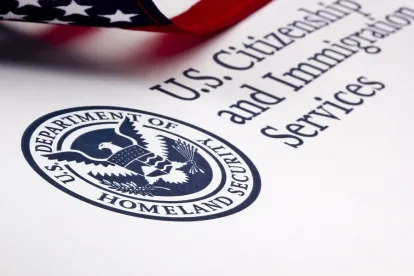On November 18, US Citizenship and Immigration Services (USCIS) published a final rule that significantly affects the ability of employers to employ and retain foreign national workers in the United States (Final Rule).
The Final Rule formalizes a number of procedures that have existed for some years in both the nonimmigrant and immigrant (green card) spheres and introduces certain novel provisions in both spheres. The Final Rule will become effective on January 17, 2017—before the inauguration of President-elect Donald Trump.
This alert reviews some of the most significant provisions of the Final Rule.
Formalization of Certain AC21 Provisions
The Final Rule introduces into USCIS regulations a number of mechanisms created by the American Competitiveness in the Twenty-First Century Act of 2001 (AC21). These include the following:
-
One- and three-year H-1B extensions available to foreign nationals who have started the green card process.
-
Immigrant portability mechanism that allows certain adjustment of status applicants to change employers or jobs without negatively affecting their green card processes.
-
H-1B portability mechanism that allows the start of H-1B employment before an H-1B petition is approved.
-
Methodology for calculating how much time an H-1B beneficiary may remain in the United States, taking into account time spent outside the country.
-
Methodology for determining H-1B cap exemptions based on employment by or at certain organizations.
-
Certain whistleblower protections for H-1B workers.
None of the above mechanisms are revised in a significant way by the Final Rule.
“Retention” of Certain Employment-Based Immigrant Petitions
In the interest of enhancing job portability for backlogged green card applicants, the Final Rule provides that immigrant petitions that have been approved for 180 days or more would no longer be automatically revoked because of withdrawal by the petitioner or the petitioner’s cessation of business. Such petitions will continue to be valid for immigrant petition portability and H-1B extension purposes. Beneficiaries of such petitions, however, need to obtain new job offers and new immigrant petition approvals (if applicable) before becoming permanent residents. Petitions that have been revoked for fraud or material misrepresentation, as well as petitions that are based on labor certifications that have been revoked or invalidated, are not covered by this provision. Petitions approved as a result of “USCIS error” are also not eligible for such continuing validity.
A significant impact of this provision is that it allows immigrant petition portability applications to enjoy such portability even in situations where the petitioner that filed the underlying immigrant petition has gone out of business. Under longstanding practice, immigrant petition portability has been allowed in situations where a petitioner has withdrawn an underlying immigrant petition.
Priority Date Retention
Also in the interest of enhancing job portability for backlogged green card applicants, the Final Rule seeks to clarify when such applicants may retain the priority dates from earlier filed immigrant petitions. Under the Final Rule, approved immigrant petitions remain valid for priority date retention purposes even after withdrawal by prior petitioners. Again, petitions that have been revoked for fraud or material misrepresentation, as well as petitions that are based on labor certifications that have been revoked or invalidated, are not covered by this provision.
Post-Sixth Year H-1B Extensions
The Final Rule confirms the eligibility of H-1B holders for extensions in one- and three-year increments beyond six years.
One-year H-1B extensions may be granted if at least 365 days have elapsed from the filing of a Program Electronic Management Review (PERM) labor certification application or immigrant petition, and can continue to be granted until the labor certification application or immigrant petition is denied or revoked.
Three-year H-1B extensions can be granted if an immigrant petition approval has been secured and the beneficiary’s priority date is not current. The Final Rule makes it clear that such extensions may continue to be granted while an underlying PERM labor certification application or immigrant petition is the subject of a pending appeal.
In addition, the Final Rule clarifies a number of issues related to post-sixth year H-1B extensions, about which some disagreement had existed. The Final Rule makes the following clarifications regarding post-sixth year H-1B extensions:
-
The beneficiary of an H-1B petition and extension application need not be in H-1B status at the time the petition and application are filed.
-
Post-sixth year H-1B extension applications may be filed before the requisite 365-day PERM application or immigrant petition pendency has been reached.
-
In seeking further H-1B extensions after the initial extension has been approved, the qualifying PERM application or immigrant petition need not be the same as that used in obtaining the initial extension. This seems to suggest that PERM applications and immigrant petitions filed after the six-year limit has been reached will serve as bases for future H-1B extensions.
-
Three-year H-1B extensions are made unavailable if the H-1B beneficiary has failed to file an adjustment of status or immigrant visa application within one year of the individual’s priority date becoming current.
60-Day Post-Termination Grace Periods for Nonimmigrant Workers
The Final Rule allows employees in E-1, E-2, E-3, H-1B, H-1B1, L-1, and TN status to receive a “one time” grace period of up to 60 days after termination of employment to remain in the United States to seek new employment or wind down their personal affairs. Employment during the 60-day grace period is not permitted. Nonimmigrants in O-1 status are not eligible for such grace periods. This signifies a welcome retreat from the USCIS’s traditional position that nonimmigrant status ends immediately upon the termination of employment.
USCIS will have discretion to reduce or disallow the 60-day grace period on a case-by-case basis.
10-Day Grace Periods for H-1B Workers Extended to Other Nonimmigrants
The regulatory provision that allows H-1B workers to enter the United States 10 days before the start of the validity period of their H-1B petitions and to defer their departure from the country for up to 10 days after such a period ends is expanded by the Final Rule to cover nonimmigrants in E-1, E-2, E-3, L-1 and TN status. Employment during the 10-day grace period is not permitted, but the commentary to the rule indicates that employment may be sought during the period. Again, nonimmigrants in O-1 status are not eligible for such grace periods.
Eligibility for EADs for Certain Immigrant Petition Beneficiaries
A provision in the Final Rule allows certain immigrant petition beneficiaries whose priority dates are not current to received Employment Authorization Documents (EADs) in one-year increments if they hold E-3, H-1B, H-1B1, L-1, or O-1 status and are experiencing “compelling circumstances.” The Final Rule does not illuminate what constitutes a “compelling circumstance” but provides a series of examples—including serious illness and disability, employer retaliation, substantial harm to the foreign national, and significant disruption to the employer. The “significant disruption” category includes a situation where an L-1 worker becomes ineligible for this status as a result of corporate reorganization. A determination of whether or not a compelling circumstance exists will be solely within the discretion of the USCIS.
Extension of EAD Validity for Renewal Applicants
The Final Rule allows certain EAD renewal applicants to receive automatic 180-day extensions of employment authorization, provided that the renewal application was timely filed and is based on the same employment authorization category as the prior EAD. It should be noted that this automatic extension is not available to spouses of E-1, E-2, E-3, H-1B, and L-1 nonimmigrants who are seeking renewals of EADs based upon their derivative status.
The Final Rule also formally eliminates the regulatory requirement that EAD applications be adjudicated within 90 days of filing and that interim EADs be issued after the 90-day period. This requirement was widely ignored by the USCIS, so this elimination is largely of academic interest.



 />i
/>i

